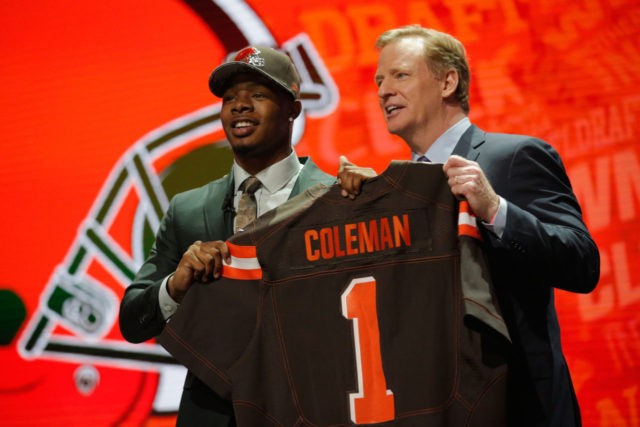In January, the Cleveland Browns hired longtime baseball executive Paul DePodesta to run their football operation. It looks like there’s going to be a learning curve for the new Browns football chief.
DePodesta, the former general manager of the Los Angeles Dodgers, and executive with the Cleveland Indians, Oakland Athletics, and New York Mets, advocates the “Moneyball” concept, which relies heavy on analytics.
While “Moneyball” has been used for a long time in baseball, it’s relatively new to football. DePodesta might need to tweak his computer program a little.
It’s too early to call his first Browns draft a failure. But on paper it doesn’t look great. The team made multiple trades to acquire 14 draft picks, double the allotted amount from the league. They might not have gotten a lot of bang for their buck.
“This was not a bonanza, but it should’ve been,” wrote ESPN draft guru Mel Kiper.
With the 15th pick of the first round, the Browns selected Baylor WR Corey Coleman, an undersized receiver with short arms and small hands. Coleman has a lot of talent, but this seemed like a reach. Also, small, fast receivers peopled the roster last year, and they constantly got hurt.
The Browns picked a total of four receivers in this draft.
If DePodesta thinks that drafting a lot of receivers will help prop up Browns quarterback Robert Griffin, he’s likely mistaken. This is a flawed concept you hear a lot from the peanut gallery: “The quarterback doesn’t have enough weapons.”
Many astute coaches will tell you, “Quarterbacks make receivers, receivers don’t make quarterbacks.”
Tom Brady’s top targets in New England include undrafted free agent Danny Amendola and seventh-round pick Julian Edelman, a college quarterback converted to a professional slot man. Russell Wilson’s starting receivers in Seattle are undrafted free agents Jermaine Kearse and Doug Baldwin.
The point is simple. Drafting wideouts, or signing big-money free agents, doesn’t make a quarterback read defenses better, enjoy better accuracy, or improve their pocket presence. That is a pipe dream.
In the second and third rounds, the Browns picked a pair of defensive ends, Oklahoma State’s Emanuel Ogbah and Penn State’s Carl Nassib. Both players possess talent, but they look like classic “tweeners” in the Browns 3-4 defense — not big enough for end, not athletic enough for outside linebacker.
One of the Browns’ fourth round picks was an injury-prone tight end out of Princeton who they probably could have signed as an undrafted free agent.
With the enigmatic Griffin currently their quarterback, people thought the Browns would pick a signal-caller higher, but they waited until the third round to pick USC’s Cody Kessler. Kessler is a cerebral quarterback with a high completion percentage, but he’s undersized and has an average arm. The Browns play in a lot of bad Cleveland weather, and it remains to be seen if Kessler has the arm strength to cut through Lake Erie’s tricky winds.
Fourteen draft picks sound great on paper. After all, the baseball draft has 40 rounds. But stockpiling picks might not be the best approach in the NFL.
First of all, you only have 53 roster spots and 10 practice squad positions. In the NFL, you have a limited amount of time to figure out what you have with the 14 picks – just a few mini-camps, training camp, and preseason games. And with the CBA signed in 2011, there are strict limitations of hitting and tackling in practices. Yes, you have four preseason games, but opponents use such vanilla strategies in these contests. The players aren’t facing the complex schemes they will see in real NFL games. So all of this makes it extra hard to discern what you have. You have just four months to do a lot of evaluating.
And let’s say you want to transfer some of your 14 draft picks to the practice squad on the final cut-down. Well, it’s not the simple. They are exposed to waivers, and some are going to be claimed by other teams, so that fact that you drafted them is of no advantage.
In baseball, having tons of draft picks works because you have an extensive minor league system – rookie Leagues along with single-A, double-A, and triple-A teams to stash all your picks, let them develop, and see what you have down the road. The NFL lacks a minor league.
Look, the Browns draft could turn out to be very good. Only time will, but DePodesta, a Harvard graduate, probably needs to alter his “Moneyball” approach moving forward as a football executive.
In the world of player personnel, football is to baseball like apples are to oranges

COMMENTS
Please let us know if you're having issues with commenting.